Boozhoo,
“Would you be interested in discussing a sculpture to memorialize the story of life along the Red Cedar River before the 1600’s?” asked Dr. Rod Olson…. And the artistic journey to create Manoomin-Food that Grows in Water began.
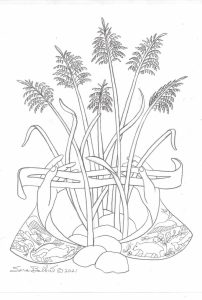
Manoomin-Food that Grows in Water conceptual design
In May, 2019, Dr. Rod Olson, representing the City of Rice Lake’s Historical Sculpture Project Committee, contacted me about my interest in creating just such a sculpture dedicated to the Paleo-Indians and the Mounds People who lived along the Red Cedar River at what is now Rice Lake. The Committee wished to memorialize these pre-European people who lived on the shores of the largest wild rice beds in North America, were on the copper trade Bayfield Trail, and quarried pipestone in the Blue Hills. The sculpture would be installed near Rice Lake’s Indian Mounds Park and tell this story of life along the river before the 1600’s.
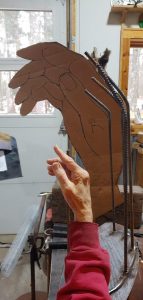
Creating the hand armatures for Manoomin
With sincere respect for the Anishinaabe (First People) history of the area, Dr. Olson presented his sculpture proposal to the Wisconsin Federation of Chippewa Tribes in July 2019. Following that presentation, the concept continued to develop with further communication and in person meetings with the Lac Courte Oreilles Tribal Governing Board, Faith Smith, Curator of the Kinnamon School-Visitors Center, tribal elders including Ernie St. Germaine shared historical perspectives.
Of special concern was the appropriateness of installing a sculpture in the vicinity of the sacred burial mounds adjacent to the site. According to Dr. Olson, Red Cliff Tribal leader Marvin Defoe made two powerful comments: “The burial mounds must be treated with the utmost respect!” and “No need to look further for a sculpture artist, Sara Balbin will create a beautiful sculpture that will represent Our People.”
From the initial email inquiry, two and a half years of focused effort were dedicated to the design, fabrication and ultimately the October 15, 2022 installation followed by the dedication of Manoomin-Food that Grows in Water. The sculpture is one of four historical sculptures situated in what is now the Rice Lake Sculpture Park at 1085 Lakeshore Drive. Representing different times in the history of Rice Lake, metal sculptor Carl Vanderheyden of Green Bay, WI created Wooly, a wooly mammoth and Trusty Rusty, a draft horse, which were installed on the site in November 2018 and October 2019. The Bayfield Trail tree sculpture tells the tale of indigenous travel and trade pathways and was designed by Dr. Rod Olson. It was fabricated in the autumn of 2021 by a team of talented local technical support who with the assistance of Dr. Olson and members of the Historic Sculpture Project Committee cut and assembled the pieces of the life-sized tree. A bald eagle is perched in a nest on top of the tree.
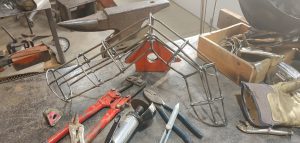
Finger armature structure
In honor of the cultural significance of the project, the Manoomin conceptual design was blessed by Lac Courte Oreilles Elder Edward Benton-Banai prior to his walking on November 30, 2020. Paul DeMain (Skabewis) and Brian McInnes (Waabi Makwa) who presented the design to Benton-Banai for approval honored the installation site with a tobacco offering and prayer prior to the project’s fabrication and foundation stages. In the early design phase tribal elder Ernie St. Germaine offered his perspectives on the importance of water and the manoomin (wild rice), that was so integral to the Anishinaabe’s survival and daily life. Lac Courte Oreilles artist, Ramona Morrow, designed traditional floral patterns that are etched in and around the eight Ojibwe clan animal images I designed for the cuffs. The clan animal designs were inspired by Benton-Banai’s The Mishomis Book, a highly recommended reading on Ojibwe history and traditions.
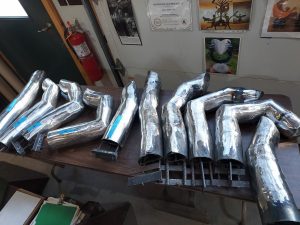
Fingers ready for placement on hand structure
Thematically, Manoomin portrays the importance of the annual harvest of wild rice to the Ojibwe people. It sustained their existence and strengthened them as a people throughout time. The ten-foot-tall rice stalks stand tall in clear water hanging heavy with abundant rice kernels waiting to provide nourishment. Mother Earth’s hands reach out through the living waters that nourished the plentiful Manoomin beds. The timeless tales of the Anishinaabe are told in the clan images and floral patterns etched into the cuffs. High atop one of the rice stalks is a stainless-steel dragonfly representing metamorphosis, changes in culture, natural settings and individual life stages as time moves through space. The locally sourced rose stone landscaped mound and river rock accents speak to the ancient geologic history of the Rice Lake area and the native peoples who inhabited it long ago and who continue to thrive today.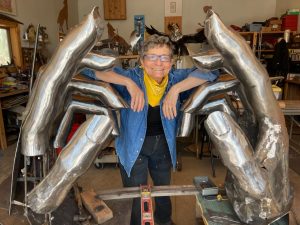
I am thankful for the many who supported the creation of Manoomin, most notably the members of the City of Rice Lake Historical Sculpture Project Committee, especially Dr. Rod Olson and Doug Edwardsen and their spouses. I extend much gratitude to my husband Gary Crandall, who helped guide the administration, fabrication and installation phases of Manoomin.
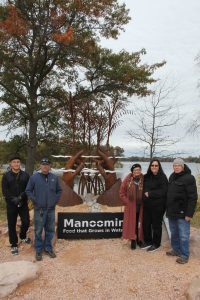
Makwa, Skabewis, Sara, Ramona Morrow and Doug Edwardsen
When viewing a finished installation hidden is the collaboration that is needed to achieve the vision. For this I want to applaud the long list of those who helped on the spur of the moment when we needed lifting power, technical consultation, emotional support, and encouragement including: Ashland Industries, Chicago Iron and Supplies, Stein Brothers Steel, Cable Home and Lumber, City of Rice Lake public works department, Nick the Welder at May Day Portable Welding, Butch, Jim, Mike, Ed, Carl, Dan, Tony, Dave, Brian, Carol, Irv, Chris, Pat, Linda, Monte, and so many more.
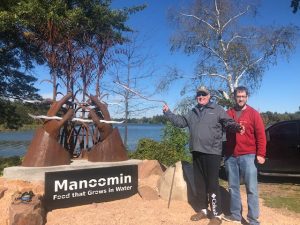
Dr. Rod Olson and son Brent celebrate Manoomin-Food that Grows in Water
Finally, I must mention once again, that this project would not have been possible without the initial vision and positive drive of Dr. Rod Olson. His passion for knowledge, especially local history, congenial nature, indomitable spirit, tireless work ethic, and will to live through a very challenging personal journey, provided great inspiration to me and my team along the path of creating Manoomin-Food that Grows in Water.
Chi miigwetch!
Postscript
On November 4, 2022 Dr. Rod Olson walked on from this earthly world to his reward in the next. In his transition, he left behind an abundant legacy of his healing nature, advocacy for the planet, respect for history, tireless work ethic, community engagement, congenial nature and friendship to all who knew him. Forever in our memory, Rest in Peace Dr. Rod.





































































































It has been following your career Sara. What gifts you have that the rest of us get to enjoy
Dave and Connie